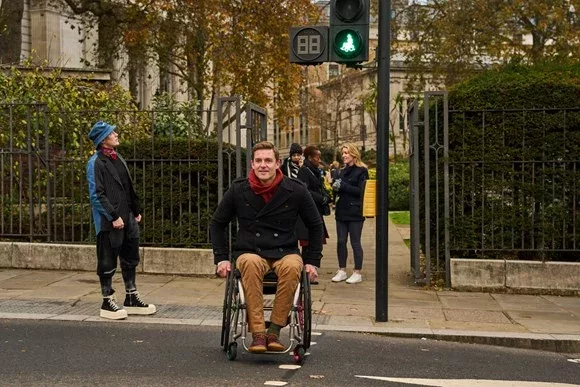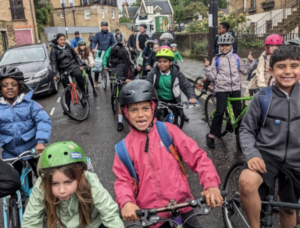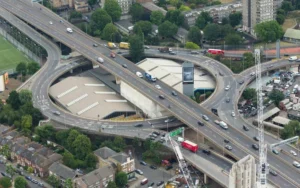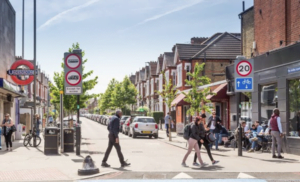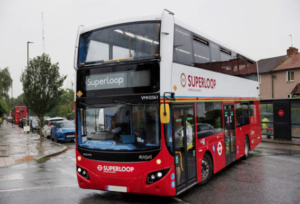Olympic rowing champion, Pete Reed OBE collaborates with TfL to introduce wheelchair user traffic light signals to represent disabled people ahead of International Day of Persons with Disabilities
New green wheelchair user traffic light signals installed at five prominent pedestrian crossings across London in Earl’s Court, King’s Cross, Liverpool Street, Tower Hill and Whitechapel
The new wheelchair user traffic signals were suggested by three-time Olympian rowing champion Pete Reed OBE who experienced a spinal stroke in 2019
The signals are installed by Yunex Traffic for no cost ahead of International Day of Persons with Disabilities, Sunday 3 December
TfL has previously reflected diversity at pedestrian traffic signals and introduced designs to celebrate the LGBTQ+ community around Trafalgar Square in 2016 and green woman traffic signals at 20 locations across London in 2021
Transport for London (TfL) has worked with Olympic rowing champion, Pete Reed OBE to introduce green wheelchair user traffic signals to represent disabled people ahead of International Day of Persons with Disabilities on Sunday 3 December.
From today, Londoners and visitors to the capital will see the specially designed wheelchair user symbols at pedestrian crossings in Earl’s Court, King’s Cross, Liverpool Street, Tower Hill and Whitechapel thanks to Yunex Traffic who installed the signals at no cost. The locations for the new wheelchair user traffic signals have been carefully selected based on their proximity to busy Tube stations, which offer step-free access.
The new symbols were inspired by three-time Olympian gold medal winning rower Pete Reed OBE who in 2019 experienced a spinal stroke which left him paralysed from his chest down. Pete Reed approached TfL with his idea of a wheelchair user traffic signal because he wanted to draw attention to the large disabled population in London and beyond, for whom access and ease of travel is essential to make the most of the city, as well as ensuring that traffic signals are representative of disabled people in a diverse and inclusive global city.
Pete Reed OBE, said: “As an Olympic athlete and naval officer, I spent my early adult life at the peak of human fitness. In 2019, in one day everything changed for me. My life now as a full-time wheelchair user has a whole range of new demands, which can be dramatically helped by better access and transport for wheelchair users, just as there should also be for the wider disabled community.
“I’m so delighted that the Mayor of London and TfL listened with open ears when I proposed these new wheelchair user traffic signals. What are only five traffic lights to one Londoner represent progress, positivity and possibility to another. The disabled community can and do offer so much value to all parts of society – I hope this visibility in mainstream life makes more people feel comfortable about getting out in the city and raising their voices where they see opportunity for positive change and collaboration.”
London’s Walking and Cycling Commissioner, Will Norman, said: “London’s diversity is one of its biggest strengths and the Mayor wants everyone, whether resident, visitor or worker, to be able to participate in and enjoy all that our great city has to offer.
“It’s fantastic to be partnering with Pete Reed OBE ahead of the International Day of Persons with Disabilities. The introduction of these traffic signals will increase the visibility of disabled people while highlighting the work that the Mayor and TfL are doing to ensure that London’s transport network is accessible for everyone, helping to build a better, fairer London for all.”
Andy Lord, London’s Transport Commissioner, said: “It is vitally important that we do more to increase awareness of disabled Londoners across our city alongside continuing to improve services for people who have accessibility needs. This is why it has been fantastic to work with Pete Reed and our accessibility partners to create these wheelchair user traffic signals and to install them in prominent locations close to busy step-free access stations on our network, so that thousands of people will see them every day.
“These new traffic signals along with our commitment to looking at how we can help make traffic signals easier to use, our work to provide more stations with step-free access and to keep streets free from clutter are all part of many different ways that we’re making London a more accessible city for all.”
The new wheelchair user traffic signals have been introduced ahead of International Day of Persons with Disabilities on Sunday 3 December. TfL is also looking at how to make pedestrian crossings more accessible and is currently running a trial at the temporary crossings at Manor Circus, which involves a remote-control button via a mobile app or separate handheld Bluetooth wireless device. This has been developed for people unable to use the push-button on crossings, allowing them to remotely call the pedestrian crossing and safely cross the road.
The new wheelchair user traffic signals will replace the green man symbol at the five locations and TfL worked closely with its Independent Disability Advisory Group (IDAG) and other key disability campaigners to ensure that the signs best reflect wheelchair users. There are two designs showing a person using an independently controlled manual wheelchair and a person using an electric wheelchair.
Alan Benson, Co-Chair of Trustees for Transport for All, said: “It’s really important to have disabled people represented in the signs and symbols of society. But these signals aren’t mere window dressing. They are a visual representation of TfL’s efforts to make London’s streets more accessible. The innovative trial at Manor Circus paves the way for a step change in road crossings in the capital.”
The reimagined symbols improve the visibility of disabled people on London’s streets and have been created in line with the safety features of the green man figure, ensuring pedestrians relying on the green signal to cross the road can still recognise the cue indicating it is safe to do so. TfL has engaged with safety experts to minimise any confusion to pedestrians using the crossings and has completed a thorough risk assessment and secured technical approvals for the wheelchair user signals. Other traffic signals at the five crossings including the red stop lights for pedestrians remain unchanged.
Wilke Reints, Managing Director of Yunex Traffic in the UK, said: “Equality, diversity and inclusion are hugely important in our business and so we are delighted to have been able to support International Day of Persons with Disabilities in such a special way.
“We work in close partnership with TfL to provide and maintain a range of traffic signal and control solutions across the city and were pleased to be able to work together to support this year’s event in this unique and memorable way.”
TfL is also working hard with all London councils to make pavements more accessible for disabled people by helping to remove clutter from streets such retail signage, as well as working closely with dockless bike and e-scooter companies to ensure they are parked correctly.
On the Tube and rail network, TfL has recently announced the next ten stations to be prioritised for step-free access. Trains on the Central line, one of the busiest lines on the Tube, are also undergoing extensive overhaul work and will feature dedicated wheelchair spaces, better lighting and new grab poles. Following a successful, trial mini-ramps will be introduced early next year at step-free access Underground stations where there is a small gap between the train and platform.
TfL and Google are also collaborating to provide Google Street View within thirty Tube stations across London, which is hoped will be particularly helpful for customers with accessibility needs in planning their journeys. The images will be launched throughout 2024, allowing customers to get a better sense of the layout of the stations when planning journeys or interchanging between different Tube lines at stations, as well as identify key facilities such as toilets, lifts and help points.
TfL has updated the Electronic Service Update Boards to make information about lift services easier to understand and to reduce the time for the board to display the relevant information. A self-reporting lifts project is also underway to enable automatic updates regarding when lifts are in and out of service and customers will see this updated on TfL’s journey planner, the TfL Go app, third-party navigation apps as well as in stations.



